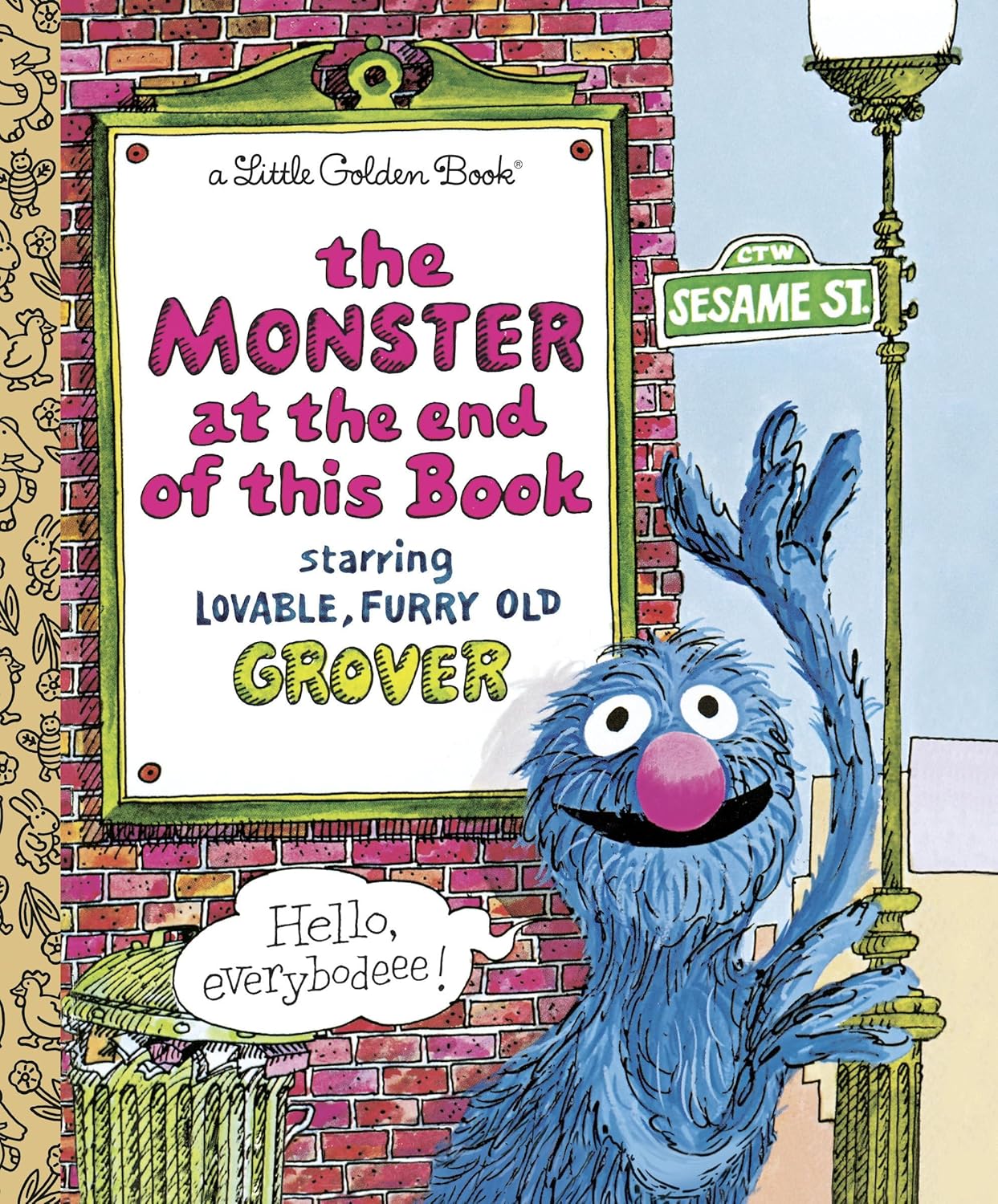Book Summary
In The Monster at the End of This Book, Sesame Street’s beloved Grover spirals into comic panic upon discovering the book’s ominous title. Through 24 brilliantly paced pages, he begs readers not to turn pages (lest they reach the dreaded monster), constructing increasingly elaborate barriers like ropes, wooden planks, and brick walls—all futile against children’s innate curiosity . The payoff—revealing Grover himself as the harmless “monster”—delivers a masterclass in suspense and irony that has delighted generations since its 1971 debut, selling over 13 million copies worldwide .
Stone’s genius lies in transforming a simple meta-joke into an immersive experience. Grover’s fourth-wall-breaking pleas (“DID THAT SAY THERE WILL BE A MONSTER??”) and Smollin’s expressive illustrations create participatory storytelling where kids gleefully defy instructions—a rebellious thrill that balances Grover’s exaggerated distress with warmth. While some critics note the book’s “sadistic” edge (Grover’s genuine terror contrasts with readers’ laughter), most agree it’s a perfect primer on narrative tension and emotional resilience .
Key Themes
The book explores fear versus curiosity through Grover’s escalating dread and children’s irresistible urge to “disobey.” This dynamic mirrors childhood’s universal tension between safety and exploration, with Grover’s overreaction modeling how fears often dwarf reality. As one reviewer notes, the twist teaches kids that “monsters” (literal or metaphorical) are frequently misunderstood aspects of ourselves—a lesson amplified by Grover’s sheepish “Oh, I am so embarrassed” finale .
Equally profound is its introduction to book mechanics. By treating pages as physical obstacles (nailed shut, tied with ropes), Stone demystifies reading as an active process. Scholars credit this with pioneering “metafiction” for preschoolers, inspiring later works like Don’t Let the Pigeon Drive the Bus. The book’s interactive DNA even influenced video game narratives, with its “fail-forward” structure (Grover’s barriers always fail, rewarding persistence) .
What Makes It Unique
As one of the first children’s books to break the fourth wall, Stone’s creation revolutionized participatory storytelling. Unlike traditional narratives, Grover speaks directly to readers (“YOU TURNED ANOTHER PAGE!”), making them co-conspirators against his futile resistance. This technique—now commonplace in titles like Press Here—was groundbreaking in 1971, especially within the “lowbrow” Little Golden Books series . The book’s enduring appeal lies in this alchemy of simplicity and innovation: a single joke stretched taut across 24 pages, with every turn amplifying anticipation.
The collaboration between Stone (a Sesame Street head writer) and illustrator Michael Smollin also elevates the experience. Smollin’s Grover is a masterpiece of comic expression—wide-eyed terror, flailing limbs—that gives emotional weight to the gimmick. Their sequel, Another Monster at the End of This Book (1996), introduced Elmo but never matched the original’s purity. Notably, the book’s humor transcends language barriers; non-English editions retain its physical comedy, proving the universality of its storytelling.
Reader Reactions
Generations of readers cherish the book for its nostalgic and developmental value. Parents report children as young as 18 months giggling at Grover’s antics, while older kids (3–5 years) relish “defying” his pleas—a rare case where disobedience is encouraged. As thriller author Brad Parks admits, the book shaped his career: “All I’ve ever tried to do is replicate [its] unbearable compulsion to turn pages”. Goodreads reviewers praise its re-readability, with one calling it “a master class in suspense and successful twist endings”.
Some critiques focus on its emotional complexity. A vocal minority find Grover’s distress unsettling (“pure childhood giggle of joy or murder?”), while others wish for more diverse art styles beyond Smollin’s classic TV tie-in look. Yet even skeptics concede its cultural impact; the 2021 HBO Max animated special and enduring sales (ranked among Little Golden Books’ top 10) confirm its status as a rite of passage .
About the Author
Jon Stone (1931–1997) was a visionary in children’s media, serving as Sesame Street’s first head writer and principal director for 24 years. He co-created iconic characters like Big Bird and Cookie Monster, and his work earned him praise as “the most brilliant writer of children’s television material in America” (per his New York Times obituary) . A Yale School of Drama graduate, Stone brought theatrical pacing to Monster, drafted on a flight to channel his own fear of flying—an irony befitting the book’s themes .
Stone’s legacy extends beyond this book. He wrote pilots for The Muppet Show and authored other Grover adventures, but Monster remains his most personal work. His daughters recall him reading it “with huge joy,” embodying his belief that children’s stories should entertain first and moralize second. This ethos—combined with Michael Smollin’s vibrant art—secured the book’s place as a bridge between Sesame Street’s educational goals and pure storytelling magic.
Memorable Quotes
“YOU TURNED ANOTHER PAGE! WHY DID YOU DO THAT?”
— Grover’s escalating panic, capturing the book’s participatory energy . “I . . . am the monster.”
— The iconic twist, praised as “one of the most profound statements in literary history” for its lesson in self-acceptance . “Oh, I am so embarrassed.”
— Grover’s sheepish finale, transforming fear into gentle humor .
Where to Buy
Available in multiple editions, including board books for toddlers and the classic Little Golden Book format:
